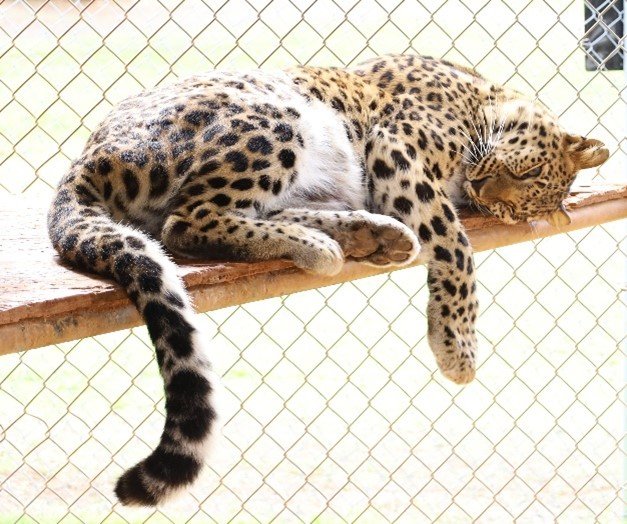amur - Amur Leopard
Amur, a unique female Amur leopard (Panthera pardus orientalis), was born May 11, 2017, came to the Foundation as a gift for our education program to inspire our visitors to help ensure that animals like this will be around for future generations.
The Amur leopard, also known as the Far Eastern leopard, show the strongest and most consistent divergence in pattern. The coat of the Amur leopard is fairly soft with long and dense hair and the color varies from a fairly light yellow to dense yellowish-red in winter and a brighter more vivid coloration in summer. The Amur leopard also has widely spaced rosette spots that cover its body. The Amur leopard has long limbs and is well adapted to walking through deep snow. Amur leopards are also able to run up to 37 miles per hour and can leap more than 19 feet horizontally and up to 10 feet vertically.
Amur leopards are crepuscular; they usually begin hunting shortly before sunset, then they are active again in the early morning and rest during the day. The Amur leopard is a solitary animal unless the female has offspring. Amur leopards are extremely conservative in their choice of territory with two individual’s territory only slightly overlapping if at all. The leopard’s territory is generally located in a river basin and the size of the territory ranges from 19 to 116 square miles.
Amur leopards will sometimes use the same hunting trails and they mainly prey on roe and sika deer, Manchurian wapiti, musk deer, moose, and wild pig. On rare occasions, they will hunt hare, badger, fowl, and mice.
The Amur leopard breeds in the late winter months, usually around January and February, so its cubs are born between April and June. The Amur leopard’s cubs are weaned at three months of age and the young usually leave their mother around one and a half to two years of age.
Amur leopards are native to the Primorye region of southeastern Russia and the Jilin Province of northeast China. The Amur leopard is the only species of leopard that is adapted to a cold snowy climate. The main threats to the Amur leopard population are due to poaching, habitat loss, decline in prey population, and potential inbreeding because of a small gene pool. There is between 50 and 60 individual Amur leopards estimated to survive in the wild and only approximately 40 in the United States.
Amur Leopard Statistics:
Body Size
Weight
Gestation Period
Litter Size
Life Span
Status
3.5 - 4.5 feet long, tail is 2.5 - 3 feet long
males: 70 - 105 pounds females: 55 - 95 pounds
90 - 105 days
2 - 3 cubs
10 - 15 years in the wild, up to 20 years in captivity
critically endangered


